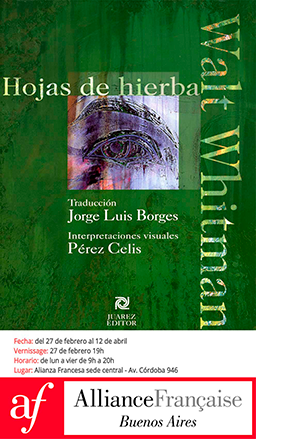(RE)DISCOVERING SARAH GRILO AT MAISTERRAVALBUENA
Madrid-based Maisterravalbuena proposes a vindication of the work of Sarah Grilo (Buenos Aires, Argentina,1917 - Madrid, Spain, 2007) through Soluciones para pensar, the second exhibition on this artist at the gallery. With a didactic and rediscovery vocation, the exhibition gathers a selection of paintings in different formats made between the 1960s and 1990s, many of them unpublished to the public. This work of selection and direct work of the gallery with the archive and the legacy of the Argentinean artist becomes fundamental in the structuring of the objective of creating opportunities for a greater knowledge of Grilo's work.
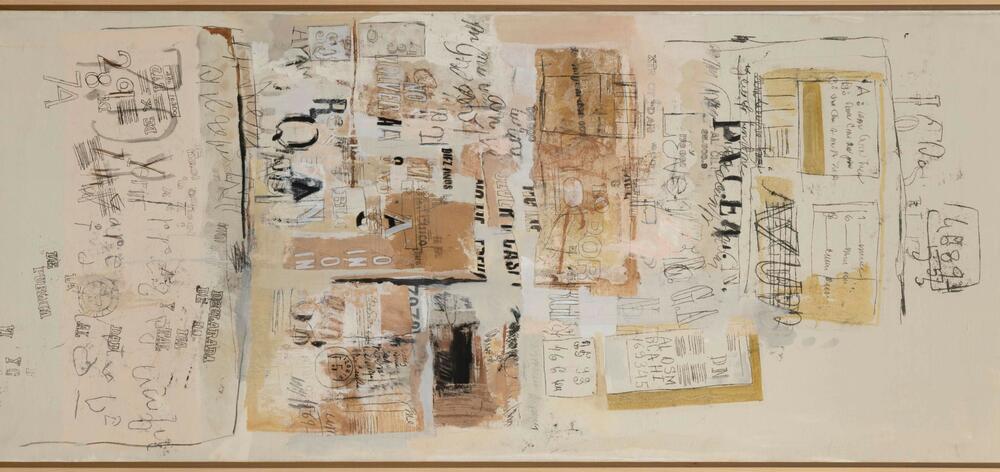
In this way, the proposed tour traces a practically testimonial line of the artistic and social influences that the artist experienced in first person, not only as a witness, in one of the most relevant periods of the New York in which she lived in the sixties and seventies. An attentive look at her canvases reveals a diatribe between the strictest academicism and permeability to new trends that emerge and rubs, but that, against a choice, assimilates them to coexist in the creation of a unique and own language.
The strength of the stroke in many of the works exhibited appears controlled, perhaps the result of that drive more technical than impetus, but recognizes the influence of a latent expressionism that forms part of her aesthetic. The balance of the grids and segmentation originates a certain verticality and formal straightness that also underlies as a substrate of an early approach to geometric abstractions and serves as a controlled space for the population of signs and elements of the big city.
The typographies, the lights and the almost unconscious acceptance of the impact of the advertising and capitalist projection to her credit endow a tangential pop possibility in the reading of her canvases. All the disorder of Grilo’s own vital inertia flows with a certain order in the urban layouts, straight, but full of objects and experiences that abound in an anonymous individualism. He does not leave aside, nor does he pretend to, any impulse of the new aesthetics or the presence of the media and its sociology, but he sifts them and processes them under a personal mark that will lead her to work in a constant semiotics of the elements and the information.
All this will continue to be present throughout her production, some of it condemned to ostracism until there are occasions such as the present one, and which denotes a valid technical continuity in which the chromatic will also vary according to the artist’s life trajectories. However, if we consider her work as a diary or notebook, it is evident the use of more vivid colors at a time when the Mediterranean environments of her Barcelona or Marbella are present to the detriment of the urban pigment, more muted perhaps, but never forgetting the artist's trajectory or denying what she has lived, consolidating a continuous learning that we are now allowed to enjoy in a more complete way.
Sarah Grilo: Soluciones para pensar can be seen until May 3 at Maisterravalbuena, Hospital, 8, Madrid (Spain).
Related Topics
May interest you
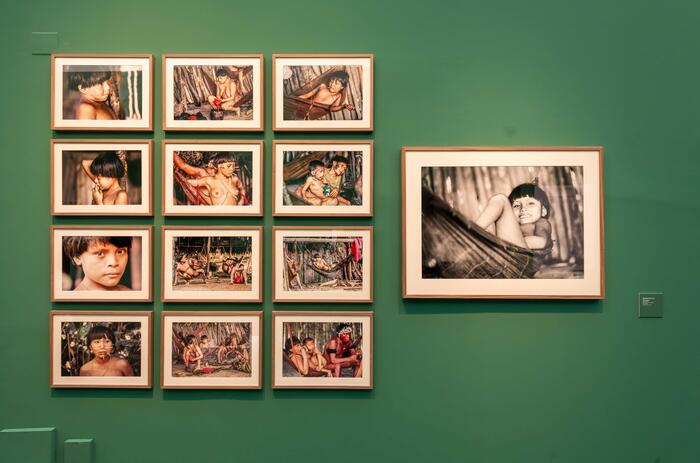
Madrid's CentroCentro approaches the artistic production related to the Amazon with the exhibition Trópico sin tópico: Amazonas (Tropic without Topic: Amazon), curated by Halim Badawi (Barranquilla, Colombia, 1982), and with which it intends to facilitate new looks beyond the usual ones with which the European imaginary contemplates the indigenous legacy and its relation with the contemporary world.
THE REVERSION OF AMAZONIAN CLICHÉS AT CENTROCENTRO
Madrid's CentroCentro approaches the artistic production related to the Amazon with the exhibition Trópico sin tópico: Amazonas (Tropic without Topic: Amazon), curated by Halim Badawi (Barranquilla, Colombia, 1982), and with which it intends to facilitate new looks beyond the usual ones with which the European imaginary contemplates the indigenous legacy and its relation with the contemporary world.

Madrid's CentroCentro approaches the artistic production related to the Amazon with the exhibition Trópico sin tópico: Amazonas (Tropic without Topic: Amazon), curated by Halim Badawi (Barranquilla, Colombia, 1982), and with which it intends to facilitate new looks beyond the usual ones with which the European imaginary contemplates the indigenous legacy and its relation with the contemporary world.
THE REVERSION OF AMAZONIAN CLICHÉS AT CENTROCENTRO
Madrid's CentroCentro approaches the artistic production related to the Amazon with the exhibition Trópico sin tópico: Amazonas (Tropic without Topic: Amazon), curated by Halim Badawi (Barranquilla, Colombia, 1982), and with which it intends to facilitate new looks beyond the usual ones with which the European imaginary contemplates the indigenous legacy and its relation with the contemporary world.
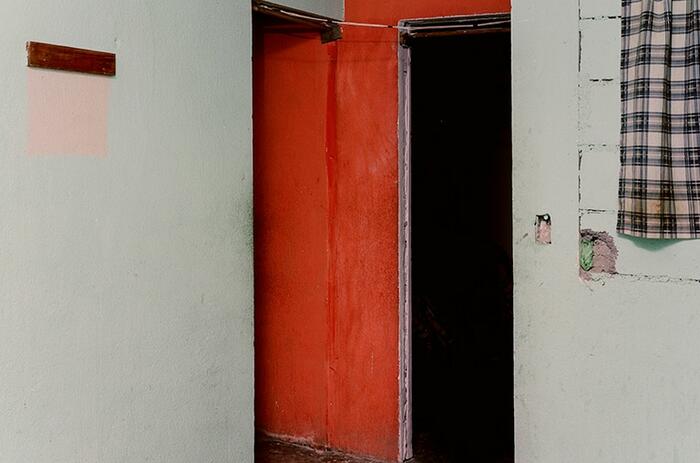
Felipe Romero (Bogota, Colombia, 1992) usually shows in his photographic proposal a high interest in conflict zones. While the scenario reflects this palpable but still intangible tension, it also serves as a reflective framework where the conflict and its protagonists meet.
BORDER HOPELESSNESS THROUGH THE LENS OF FELIPE ROMERO
Felipe Romero (Bogota, Colombia, 1992) usually shows in his photographic proposal a high interest in conflict zones. While the scenario reflects this palpable but still intangible tension, it also serves as a reflective framework where the conflict and its protagonists meet.

The Hochschild Correa Collection boasts of being the most complete private collection of contemporary art from the Peruvian Amazon. Nevertheless, for more than a decade, it has been built on a varied and unrestricted collection, which has made it possible to bring together the different trends and techniques currently being used in the region, with a focus on dialogue and a certain relational patina among the works that make up the collection.
PERUVIAN AMAZONIAN ART THROUGH THE HOCHSCHILD CORREA COLLECTION
The Hochschild Correa Collection boasts of being the most complete private collection of contemporary art from the Peruvian Amazon. Nevertheless, for more than a decade, it has been built on a varied and unrestricted collection, which has made it possible to bring together the different trends and techniques currently being used in the region, with a focus on dialogue and a certain relational patina among the works that make up the collection.

La Casa Encendida is planning a large part of its artistic, exhibition program this season around the concept of Verbos encendidos, a framework line of argument that frames the theme and the perspective from which certain public, political and social issues are approached from the institution. Escuchar (Listen) is the first verb, chosen to start with it a call for attention towards the construction of spaces and tools that allow to overcome differences and find common spaces of understanding.
ALLORA & CALZADILLA'S FABLE ON LISTENING
La Casa Encendida is planning a large part of its artistic, exhibition program this season around the concept of Verbos encendidos, a framework line of argument that frames the theme and the perspective from which certain public, political and social issues are approached from the institution. Escuchar (Listen) is the first verb, chosen to start with it a call for attention towards the construction of spaces and tools that allow to overcome differences and find common spaces of understanding.
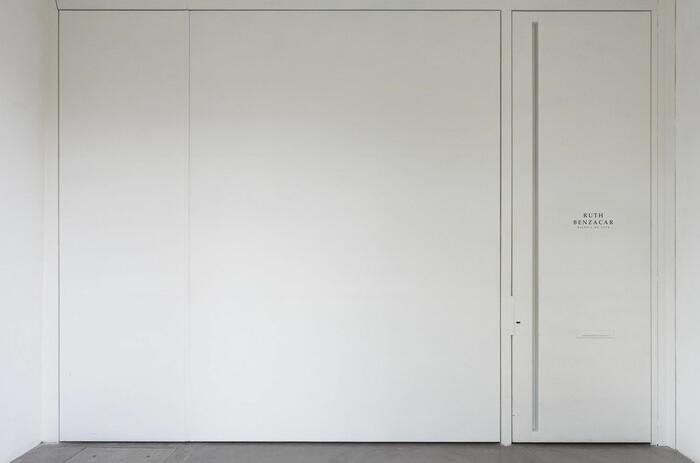
The institution commemorates six decades of trajectory reaffirming its commitment to Argentine artistic production and the continuous development of its scene. To kick off the great year, it presents Estudio para la restauración de un perfil (Study for the Restoration of a Profile) by Ana Gallardo and Alquimia para tiempos turbios (Alchemy for Turbulent Times) by Marina De Caro.
RUTH BENZACAR GALLERY OF ART CELEBRATES 60 YEARS OF HISTORY
The institution commemorates six decades of trajectory reaffirming its commitment to Argentine artistic production and the continuous development of its scene. To kick off the great year, it presents Estudio para la restauración de un perfil (Study for the Restoration of a Profile) by Ana Gallardo and Alquimia para tiempos turbios (Alchemy for Turbulent Times) by Marina De Caro.
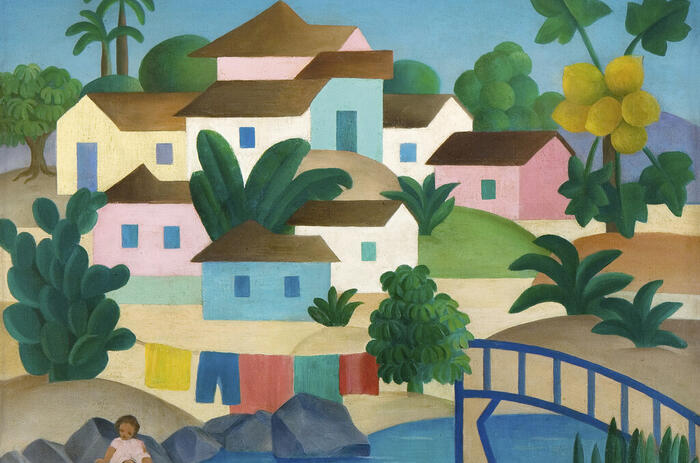
The Guggenheim Museum Bilbao hosts a retrospective exhibition of Tarsila do Amaral (Capivari, Brazil, 1886 - São Paulo, Brazil, 1973) focused on her conception and renovation of painting, as well as on her recognition as one of the key and most representative figures of the entry of avant-garde and modernizing pictorial languages in Latin America. A central name in Brazilian modernism, her style was consecrated as her own identity, a product of her desires and experiences, evoking both indigenous themes and the modernizing processes of a Brazil that was undergoing a constant transformation.
THE MODERNITY OF TARSILA DO AMARAL TAKES OVER THE GUGGENHEIM IN BILBAO
The Guggenheim Museum Bilbao hosts a retrospective exhibition of Tarsila do Amaral (Capivari, Brazil, 1886 - São Paulo, Brazil, 1973) focused on her conception and renovation of painting, as well as on her recognition as one of the key and most representative figures of the entry of avant-garde and modernizing pictorial languages in Latin America. A central name in Brazilian modernism, her style was consecrated as her own identity, a product of her desires and experiences, evoking both indigenous themes and the modernizing processes of a Brazil that was undergoing a constant transformation.
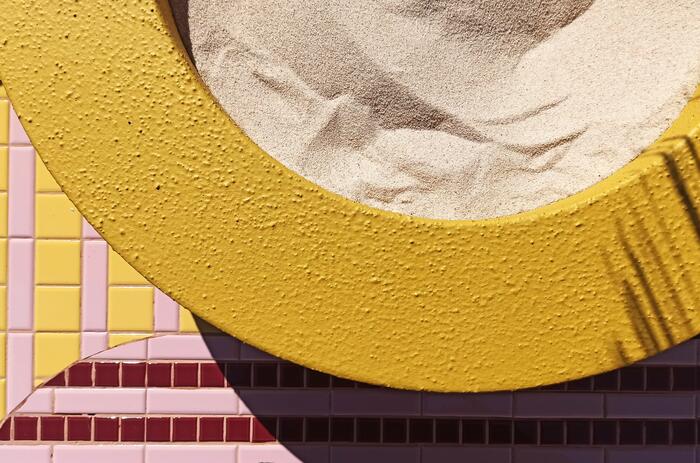
The intervention Wasi Llamkha (Place and touch), by artist Andrea Canepa (Lima, Peru, 1980), stands on the South Patio of Madrid's Condeduque. This pavilion, designed as an ephemeral architectural structure, invites us to explore its sensorial value, far from the preeminence of the visual, and claims, by way of inspiration, the quipus, the forms of representation and recording of information from pre-Columbian Peru.
SPACE AND SENSES IN ANDREA CANEPA
The intervention Wasi Llamkha (Place and touch), by artist Andrea Canepa (Lima, Peru, 1980), stands on the South Patio of Madrid's Condeduque. This pavilion, designed as an ephemeral architectural structure, invites us to explore its sensorial value, far from the preeminence of the visual, and claims, by way of inspiration, the quipus, the forms of representation and recording of information from pre-Columbian Peru.
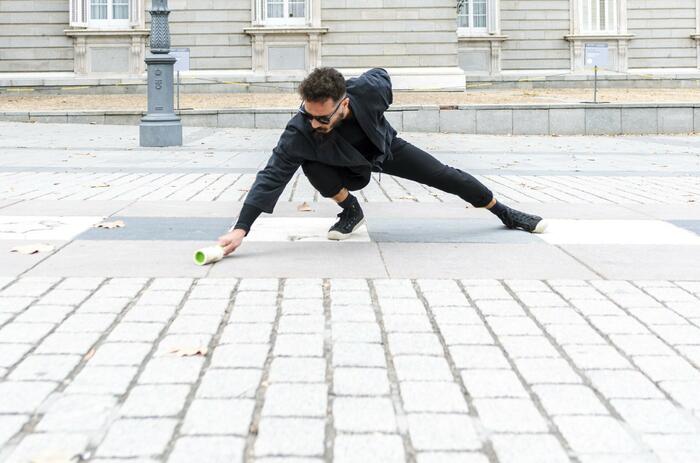
Intricate between action and register, El Apartamento hosts Algo deja quien se va, the first solo exhibition in Spain by Reynier Leyva Novo (Havana, Cuba, 1983). Starting from the political concept of historical memory and linking it to the issues of power and colonialism, the artist unfolds in two well-differentiated series his proposal to approach these lines, and extends his networks to the impact (or influence) they have on the institutional and cultural fabric.
LEYVA NOVO: DUST IT IS AND TO DUST IT WILL TURN
Intricate between action and register, El Apartamento hosts Algo deja quien se va, the first solo exhibition in Spain by Reynier Leyva Novo (Havana, Cuba, 1983). Starting from the political concept of historical memory and linking it to the issues of power and colonialism, the artist unfolds in two well-differentiated series his proposal to approach these lines, and extends his networks to the impact (or influence) they have on the institutional and cultural fabric.
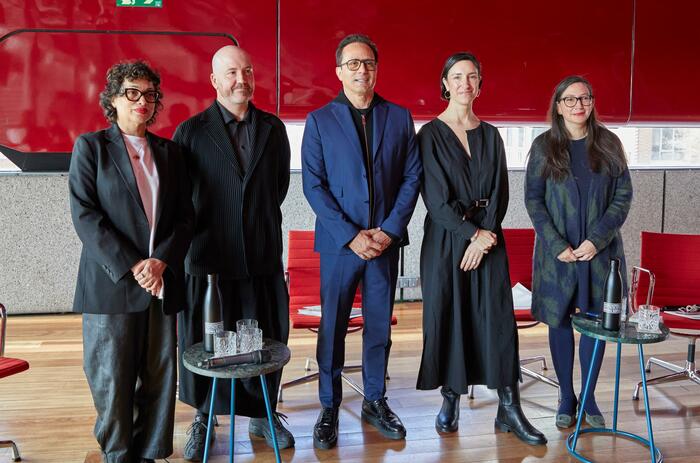
Madrid's Reina Sofia Museum, in collaboration with the Reina Sofia Museum Foundation, reinforces its growing involvement and strategy for the dissemination and study of Latin American contemporary art with the creation of the Cáder Institute of Central American Art (ICAC), dedicated to the research and dissemination of Central American art.
THE CENTRAL AMERICAN ART INSTITUTE (ICAC) OF THE REINA SOFIA MUSEUM IS BORN
Madrid's Reina Sofia Museum, in collaboration with the Reina Sofia Museum Foundation, reinforces its growing involvement and strategy for the dissemination and study of Latin American contemporary art with the creation of the Cáder Institute of Central American Art (ICAC), dedicated to the research and dissemination of Central American art.

Madrid's CentroCentro approaches the artistic production related to the Amazon with the exhibition Trópico sin tópico: Amazonas (Tropic without Topic: Amazon), curated by Halim Badawi (Barranquilla, Colombia, 1982), and with which it intends to facilitate new looks beyond the usual ones with which the European imaginary contemplates the indigenous legacy and its relation with the contemporary world.
THE REVERSION OF AMAZONIAN CLICHÉS AT CENTROCENTRO
Madrid's CentroCentro approaches the artistic production related to the Amazon with the exhibition Trópico sin tópico: Amazonas (Tropic without Topic: Amazon), curated by Halim Badawi (Barranquilla, Colombia, 1982), and with which it intends to facilitate new looks beyond the usual ones with which the European imaginary contemplates the indigenous legacy and its relation with the contemporary world.

Felipe Romero (Bogota, Colombia, 1992) usually shows in his photographic proposal a high interest in conflict zones. While the scenario reflects this palpable but still intangible tension, it also serves as a reflective framework where the conflict and its protagonists meet.
BORDER HOPELESSNESS THROUGH THE LENS OF FELIPE ROMERO
Felipe Romero (Bogota, Colombia, 1992) usually shows in his photographic proposal a high interest in conflict zones. While the scenario reflects this palpable but still intangible tension, it also serves as a reflective framework where the conflict and its protagonists meet.

The Hochschild Correa Collection boasts of being the most complete private collection of contemporary art from the Peruvian Amazon. Nevertheless, for more than a decade, it has been built on a varied and unrestricted collection, which has made it possible to bring together the different trends and techniques currently being used in the region, with a focus on dialogue and a certain relational patina among the works that make up the collection.
PERUVIAN AMAZONIAN ART THROUGH THE HOCHSCHILD CORREA COLLECTION
The Hochschild Correa Collection boasts of being the most complete private collection of contemporary art from the Peruvian Amazon. Nevertheless, for more than a decade, it has been built on a varied and unrestricted collection, which has made it possible to bring together the different trends and techniques currently being used in the region, with a focus on dialogue and a certain relational patina among the works that make up the collection.

La Casa Encendida is planning a large part of its artistic, exhibition program this season around the concept of Verbos encendidos, a framework line of argument that frames the theme and the perspective from which certain public, political and social issues are approached from the institution. Escuchar (Listen) is the first verb, chosen to start with it a call for attention towards the construction of spaces and tools that allow to overcome differences and find common spaces of understanding.
ALLORA & CALZADILLA'S FABLE ON LISTENING
La Casa Encendida is planning a large part of its artistic, exhibition program this season around the concept of Verbos encendidos, a framework line of argument that frames the theme and the perspective from which certain public, political and social issues are approached from the institution. Escuchar (Listen) is the first verb, chosen to start with it a call for attention towards the construction of spaces and tools that allow to overcome differences and find common spaces of understanding.

The institution commemorates six decades of trajectory reaffirming its commitment to Argentine artistic production and the continuous development of its scene. To kick off the great year, it presents Estudio para la restauración de un perfil (Study for the Restoration of a Profile) by Ana Gallardo and Alquimia para tiempos turbios (Alchemy for Turbulent Times) by Marina De Caro.
RUTH BENZACAR GALLERY OF ART CELEBRATES 60 YEARS OF HISTORY
The institution commemorates six decades of trajectory reaffirming its commitment to Argentine artistic production and the continuous development of its scene. To kick off the great year, it presents Estudio para la restauración de un perfil (Study for the Restoration of a Profile) by Ana Gallardo and Alquimia para tiempos turbios (Alchemy for Turbulent Times) by Marina De Caro.

The Guggenheim Museum Bilbao hosts a retrospective exhibition of Tarsila do Amaral (Capivari, Brazil, 1886 - São Paulo, Brazil, 1973) focused on her conception and renovation of painting, as well as on her recognition as one of the key and most representative figures of the entry of avant-garde and modernizing pictorial languages in Latin America. A central name in Brazilian modernism, her style was consecrated as her own identity, a product of her desires and experiences, evoking both indigenous themes and the modernizing processes of a Brazil that was undergoing a constant transformation.
THE MODERNITY OF TARSILA DO AMARAL TAKES OVER THE GUGGENHEIM IN BILBAO
The Guggenheim Museum Bilbao hosts a retrospective exhibition of Tarsila do Amaral (Capivari, Brazil, 1886 - São Paulo, Brazil, 1973) focused on her conception and renovation of painting, as well as on her recognition as one of the key and most representative figures of the entry of avant-garde and modernizing pictorial languages in Latin America. A central name in Brazilian modernism, her style was consecrated as her own identity, a product of her desires and experiences, evoking both indigenous themes and the modernizing processes of a Brazil that was undergoing a constant transformation.

The intervention Wasi Llamkha (Place and touch), by artist Andrea Canepa (Lima, Peru, 1980), stands on the South Patio of Madrid's Condeduque. This pavilion, designed as an ephemeral architectural structure, invites us to explore its sensorial value, far from the preeminence of the visual, and claims, by way of inspiration, the quipus, the forms of representation and recording of information from pre-Columbian Peru.
SPACE AND SENSES IN ANDREA CANEPA
The intervention Wasi Llamkha (Place and touch), by artist Andrea Canepa (Lima, Peru, 1980), stands on the South Patio of Madrid's Condeduque. This pavilion, designed as an ephemeral architectural structure, invites us to explore its sensorial value, far from the preeminence of the visual, and claims, by way of inspiration, the quipus, the forms of representation and recording of information from pre-Columbian Peru.

Intricate between action and register, El Apartamento hosts Algo deja quien se va, the first solo exhibition in Spain by Reynier Leyva Novo (Havana, Cuba, 1983). Starting from the political concept of historical memory and linking it to the issues of power and colonialism, the artist unfolds in two well-differentiated series his proposal to approach these lines, and extends his networks to the impact (or influence) they have on the institutional and cultural fabric.
LEYVA NOVO: DUST IT IS AND TO DUST IT WILL TURN
Intricate between action and register, El Apartamento hosts Algo deja quien se va, the first solo exhibition in Spain by Reynier Leyva Novo (Havana, Cuba, 1983). Starting from the political concept of historical memory and linking it to the issues of power and colonialism, the artist unfolds in two well-differentiated series his proposal to approach these lines, and extends his networks to the impact (or influence) they have on the institutional and cultural fabric.

Madrid's Reina Sofia Museum, in collaboration with the Reina Sofia Museum Foundation, reinforces its growing involvement and strategy for the dissemination and study of Latin American contemporary art with the creation of the Cáder Institute of Central American Art (ICAC), dedicated to the research and dissemination of Central American art.
THE CENTRAL AMERICAN ART INSTITUTE (ICAC) OF THE REINA SOFIA MUSEUM IS BORN
Madrid's Reina Sofia Museum, in collaboration with the Reina Sofia Museum Foundation, reinforces its growing involvement and strategy for the dissemination and study of Latin American contemporary art with the creation of the Cáder Institute of Central American Art (ICAC), dedicated to the research and dissemination of Central American art.

Madrid's CentroCentro approaches the artistic production related to the Amazon with the exhibition Trópico sin tópico: Amazonas (Tropic without Topic: Amazon), curated by Halim Badawi (Barranquilla, Colombia, 1982), and with which it intends to facilitate new looks beyond the usual ones with which the European imaginary contemplates the indigenous legacy and its relation with the contemporary world.
THE REVERSION OF AMAZONIAN CLICHÉS AT CENTROCENTRO
Madrid's CentroCentro approaches the artistic production related to the Amazon with the exhibition Trópico sin tópico: Amazonas (Tropic without Topic: Amazon), curated by Halim Badawi (Barranquilla, Colombia, 1982), and with which it intends to facilitate new looks beyond the usual ones with which the European imaginary contemplates the indigenous legacy and its relation with the contemporary world.

Felipe Romero (Bogota, Colombia, 1992) usually shows in his photographic proposal a high interest in conflict zones. While the scenario reflects this palpable but still intangible tension, it also serves as a reflective framework where the conflict and its protagonists meet.
BORDER HOPELESSNESS THROUGH THE LENS OF FELIPE ROMERO
Felipe Romero (Bogota, Colombia, 1992) usually shows in his photographic proposal a high interest in conflict zones. While the scenario reflects this palpable but still intangible tension, it also serves as a reflective framework where the conflict and its protagonists meet.

The Hochschild Correa Collection boasts of being the most complete private collection of contemporary art from the Peruvian Amazon. Nevertheless, for more than a decade, it has been built on a varied and unrestricted collection, which has made it possible to bring together the different trends and techniques currently being used in the region, with a focus on dialogue and a certain relational patina among the works that make up the collection.
PERUVIAN AMAZONIAN ART THROUGH THE HOCHSCHILD CORREA COLLECTION
The Hochschild Correa Collection boasts of being the most complete private collection of contemporary art from the Peruvian Amazon. Nevertheless, for more than a decade, it has been built on a varied and unrestricted collection, which has made it possible to bring together the different trends and techniques currently being used in the region, with a focus on dialogue and a certain relational patina among the works that make up the collection.

La Casa Encendida is planning a large part of its artistic, exhibition program this season around the concept of Verbos encendidos, a framework line of argument that frames the theme and the perspective from which certain public, political and social issues are approached from the institution. Escuchar (Listen) is the first verb, chosen to start with it a call for attention towards the construction of spaces and tools that allow to overcome differences and find common spaces of understanding.
ALLORA & CALZADILLA'S FABLE ON LISTENING
La Casa Encendida is planning a large part of its artistic, exhibition program this season around the concept of Verbos encendidos, a framework line of argument that frames the theme and the perspective from which certain public, political and social issues are approached from the institution. Escuchar (Listen) is the first verb, chosen to start with it a call for attention towards the construction of spaces and tools that allow to overcome differences and find common spaces of understanding.

The institution commemorates six decades of trajectory reaffirming its commitment to Argentine artistic production and the continuous development of its scene. To kick off the great year, it presents Estudio para la restauración de un perfil (Study for the Restoration of a Profile) by Ana Gallardo and Alquimia para tiempos turbios (Alchemy for Turbulent Times) by Marina De Caro.
RUTH BENZACAR GALLERY OF ART CELEBRATES 60 YEARS OF HISTORY
The institution commemorates six decades of trajectory reaffirming its commitment to Argentine artistic production and the continuous development of its scene. To kick off the great year, it presents Estudio para la restauración de un perfil (Study for the Restoration of a Profile) by Ana Gallardo and Alquimia para tiempos turbios (Alchemy for Turbulent Times) by Marina De Caro.

The Guggenheim Museum Bilbao hosts a retrospective exhibition of Tarsila do Amaral (Capivari, Brazil, 1886 - São Paulo, Brazil, 1973) focused on her conception and renovation of painting, as well as on her recognition as one of the key and most representative figures of the entry of avant-garde and modernizing pictorial languages in Latin America. A central name in Brazilian modernism, her style was consecrated as her own identity, a product of her desires and experiences, evoking both indigenous themes and the modernizing processes of a Brazil that was undergoing a constant transformation.
THE MODERNITY OF TARSILA DO AMARAL TAKES OVER THE GUGGENHEIM IN BILBAO
The Guggenheim Museum Bilbao hosts a retrospective exhibition of Tarsila do Amaral (Capivari, Brazil, 1886 - São Paulo, Brazil, 1973) focused on her conception and renovation of painting, as well as on her recognition as one of the key and most representative figures of the entry of avant-garde and modernizing pictorial languages in Latin America. A central name in Brazilian modernism, her style was consecrated as her own identity, a product of her desires and experiences, evoking both indigenous themes and the modernizing processes of a Brazil that was undergoing a constant transformation.

The intervention Wasi Llamkha (Place and touch), by artist Andrea Canepa (Lima, Peru, 1980), stands on the South Patio of Madrid's Condeduque. This pavilion, designed as an ephemeral architectural structure, invites us to explore its sensorial value, far from the preeminence of the visual, and claims, by way of inspiration, the quipus, the forms of representation and recording of information from pre-Columbian Peru.
SPACE AND SENSES IN ANDREA CANEPA
The intervention Wasi Llamkha (Place and touch), by artist Andrea Canepa (Lima, Peru, 1980), stands on the South Patio of Madrid's Condeduque. This pavilion, designed as an ephemeral architectural structure, invites us to explore its sensorial value, far from the preeminence of the visual, and claims, by way of inspiration, the quipus, the forms of representation and recording of information from pre-Columbian Peru.

Intricate between action and register, El Apartamento hosts Algo deja quien se va, the first solo exhibition in Spain by Reynier Leyva Novo (Havana, Cuba, 1983). Starting from the political concept of historical memory and linking it to the issues of power and colonialism, the artist unfolds in two well-differentiated series his proposal to approach these lines, and extends his networks to the impact (or influence) they have on the institutional and cultural fabric.
LEYVA NOVO: DUST IT IS AND TO DUST IT WILL TURN
Intricate between action and register, El Apartamento hosts Algo deja quien se va, the first solo exhibition in Spain by Reynier Leyva Novo (Havana, Cuba, 1983). Starting from the political concept of historical memory and linking it to the issues of power and colonialism, the artist unfolds in two well-differentiated series his proposal to approach these lines, and extends his networks to the impact (or influence) they have on the institutional and cultural fabric.

Madrid's Reina Sofia Museum, in collaboration with the Reina Sofia Museum Foundation, reinforces its growing involvement and strategy for the dissemination and study of Latin American contemporary art with the creation of the Cáder Institute of Central American Art (ICAC), dedicated to the research and dissemination of Central American art.
THE CENTRAL AMERICAN ART INSTITUTE (ICAC) OF THE REINA SOFIA MUSEUM IS BORN
Madrid's Reina Sofia Museum, in collaboration with the Reina Sofia Museum Foundation, reinforces its growing involvement and strategy for the dissemination and study of Latin American contemporary art with the creation of the Cáder Institute of Central American Art (ICAC), dedicated to the research and dissemination of Central American art.

Madrid's CentroCentro approaches the artistic production related to the Amazon with the exhibition Trópico sin tópico: Amazonas (Tropic without Topic: Amazon), curated by Halim Badawi (Barranquilla, Colombia, 1982), and with which it intends to facilitate new looks beyond the usual ones with which the European imaginary contemplates the indigenous legacy and its relation with the contemporary world.
THE REVERSION OF AMAZONIAN CLICHÉS AT CENTROCENTRO
Madrid's CentroCentro approaches the artistic production related to the Amazon with the exhibition Trópico sin tópico: Amazonas (Tropic without Topic: Amazon), curated by Halim Badawi (Barranquilla, Colombia, 1982), and with which it intends to facilitate new looks beyond the usual ones with which the European imaginary contemplates the indigenous legacy and its relation with the contemporary world.

Felipe Romero (Bogota, Colombia, 1992) usually shows in his photographic proposal a high interest in conflict zones. While the scenario reflects this palpable but still intangible tension, it also serves as a reflective framework where the conflict and its protagonists meet.
BORDER HOPELESSNESS THROUGH THE LENS OF FELIPE ROMERO
Felipe Romero (Bogota, Colombia, 1992) usually shows in his photographic proposal a high interest in conflict zones. While the scenario reflects this palpable but still intangible tension, it also serves as a reflective framework where the conflict and its protagonists meet.

The Hochschild Correa Collection boasts of being the most complete private collection of contemporary art from the Peruvian Amazon. Nevertheless, for more than a decade, it has been built on a varied and unrestricted collection, which has made it possible to bring together the different trends and techniques currently being used in the region, with a focus on dialogue and a certain relational patina among the works that make up the collection.
PERUVIAN AMAZONIAN ART THROUGH THE HOCHSCHILD CORREA COLLECTION
The Hochschild Correa Collection boasts of being the most complete private collection of contemporary art from the Peruvian Amazon. Nevertheless, for more than a decade, it has been built on a varied and unrestricted collection, which has made it possible to bring together the different trends and techniques currently being used in the region, with a focus on dialogue and a certain relational patina among the works that make up the collection.

La Casa Encendida is planning a large part of its artistic, exhibition program this season around the concept of Verbos encendidos, a framework line of argument that frames the theme and the perspective from which certain public, political and social issues are approached from the institution. Escuchar (Listen) is the first verb, chosen to start with it a call for attention towards the construction of spaces and tools that allow to overcome differences and find common spaces of understanding.
ALLORA & CALZADILLA'S FABLE ON LISTENING
La Casa Encendida is planning a large part of its artistic, exhibition program this season around the concept of Verbos encendidos, a framework line of argument that frames the theme and the perspective from which certain public, political and social issues are approached from the institution. Escuchar (Listen) is the first verb, chosen to start with it a call for attention towards the construction of spaces and tools that allow to overcome differences and find common spaces of understanding.

The institution commemorates six decades of trajectory reaffirming its commitment to Argentine artistic production and the continuous development of its scene. To kick off the great year, it presents Estudio para la restauración de un perfil (Study for the Restoration of a Profile) by Ana Gallardo and Alquimia para tiempos turbios (Alchemy for Turbulent Times) by Marina De Caro.
RUTH BENZACAR GALLERY OF ART CELEBRATES 60 YEARS OF HISTORY
The institution commemorates six decades of trajectory reaffirming its commitment to Argentine artistic production and the continuous development of its scene. To kick off the great year, it presents Estudio para la restauración de un perfil (Study for the Restoration of a Profile) by Ana Gallardo and Alquimia para tiempos turbios (Alchemy for Turbulent Times) by Marina De Caro.

The Guggenheim Museum Bilbao hosts a retrospective exhibition of Tarsila do Amaral (Capivari, Brazil, 1886 - São Paulo, Brazil, 1973) focused on her conception and renovation of painting, as well as on her recognition as one of the key and most representative figures of the entry of avant-garde and modernizing pictorial languages in Latin America. A central name in Brazilian modernism, her style was consecrated as her own identity, a product of her desires and experiences, evoking both indigenous themes and the modernizing processes of a Brazil that was undergoing a constant transformation.
THE MODERNITY OF TARSILA DO AMARAL TAKES OVER THE GUGGENHEIM IN BILBAO
The Guggenheim Museum Bilbao hosts a retrospective exhibition of Tarsila do Amaral (Capivari, Brazil, 1886 - São Paulo, Brazil, 1973) focused on her conception and renovation of painting, as well as on her recognition as one of the key and most representative figures of the entry of avant-garde and modernizing pictorial languages in Latin America. A central name in Brazilian modernism, her style was consecrated as her own identity, a product of her desires and experiences, evoking both indigenous themes and the modernizing processes of a Brazil that was undergoing a constant transformation.

The intervention Wasi Llamkha (Place and touch), by artist Andrea Canepa (Lima, Peru, 1980), stands on the South Patio of Madrid's Condeduque. This pavilion, designed as an ephemeral architectural structure, invites us to explore its sensorial value, far from the preeminence of the visual, and claims, by way of inspiration, the quipus, the forms of representation and recording of information from pre-Columbian Peru.
SPACE AND SENSES IN ANDREA CANEPA
The intervention Wasi Llamkha (Place and touch), by artist Andrea Canepa (Lima, Peru, 1980), stands on the South Patio of Madrid's Condeduque. This pavilion, designed as an ephemeral architectural structure, invites us to explore its sensorial value, far from the preeminence of the visual, and claims, by way of inspiration, the quipus, the forms of representation and recording of information from pre-Columbian Peru.

Intricate between action and register, El Apartamento hosts Algo deja quien se va, the first solo exhibition in Spain by Reynier Leyva Novo (Havana, Cuba, 1983). Starting from the political concept of historical memory and linking it to the issues of power and colonialism, the artist unfolds in two well-differentiated series his proposal to approach these lines, and extends his networks to the impact (or influence) they have on the institutional and cultural fabric.
LEYVA NOVO: DUST IT IS AND TO DUST IT WILL TURN
Intricate between action and register, El Apartamento hosts Algo deja quien se va, the first solo exhibition in Spain by Reynier Leyva Novo (Havana, Cuba, 1983). Starting from the political concept of historical memory and linking it to the issues of power and colonialism, the artist unfolds in two well-differentiated series his proposal to approach these lines, and extends his networks to the impact (or influence) they have on the institutional and cultural fabric.

Madrid's Reina Sofia Museum, in collaboration with the Reina Sofia Museum Foundation, reinforces its growing involvement and strategy for the dissemination and study of Latin American contemporary art with the creation of the Cáder Institute of Central American Art (ICAC), dedicated to the research and dissemination of Central American art.
THE CENTRAL AMERICAN ART INSTITUTE (ICAC) OF THE REINA SOFIA MUSEUM IS BORN
Madrid's Reina Sofia Museum, in collaboration with the Reina Sofia Museum Foundation, reinforces its growing involvement and strategy for the dissemination and study of Latin American contemporary art with the creation of the Cáder Institute of Central American Art (ICAC), dedicated to the research and dissemination of Central American art.

Madrid's CentroCentro approaches the artistic production related to the Amazon with the exhibition Trópico sin tópico: Amazonas (Tropic without Topic: Amazon), curated by Halim Badawi (Barranquilla, Colombia, 1982), and with which it intends to facilitate new looks beyond the usual ones with which the European imaginary contemplates the indigenous legacy and its relation with the contemporary world.
THE REVERSION OF AMAZONIAN CLICHÉS AT CENTROCENTRO
Madrid's CentroCentro approaches the artistic production related to the Amazon with the exhibition Trópico sin tópico: Amazonas (Tropic without Topic: Amazon), curated by Halim Badawi (Barranquilla, Colombia, 1982), and with which it intends to facilitate new looks beyond the usual ones with which the European imaginary contemplates the indigenous legacy and its relation with the contemporary world.

Felipe Romero (Bogota, Colombia, 1992) usually shows in his photographic proposal a high interest in conflict zones. While the scenario reflects this palpable but still intangible tension, it also serves as a reflective framework where the conflict and its protagonists meet.
BORDER HOPELESSNESS THROUGH THE LENS OF FELIPE ROMERO
Felipe Romero (Bogota, Colombia, 1992) usually shows in his photographic proposal a high interest in conflict zones. While the scenario reflects this palpable but still intangible tension, it also serves as a reflective framework where the conflict and its protagonists meet.

The Hochschild Correa Collection boasts of being the most complete private collection of contemporary art from the Peruvian Amazon. Nevertheless, for more than a decade, it has been built on a varied and unrestricted collection, which has made it possible to bring together the different trends and techniques currently being used in the region, with a focus on dialogue and a certain relational patina among the works that make up the collection.
PERUVIAN AMAZONIAN ART THROUGH THE HOCHSCHILD CORREA COLLECTION
The Hochschild Correa Collection boasts of being the most complete private collection of contemporary art from the Peruvian Amazon. Nevertheless, for more than a decade, it has been built on a varied and unrestricted collection, which has made it possible to bring together the different trends and techniques currently being used in the region, with a focus on dialogue and a certain relational patina among the works that make up the collection.

La Casa Encendida is planning a large part of its artistic, exhibition program this season around the concept of Verbos encendidos, a framework line of argument that frames the theme and the perspective from which certain public, political and social issues are approached from the institution. Escuchar (Listen) is the first verb, chosen to start with it a call for attention towards the construction of spaces and tools that allow to overcome differences and find common spaces of understanding.
ALLORA & CALZADILLA'S FABLE ON LISTENING
La Casa Encendida is planning a large part of its artistic, exhibition program this season around the concept of Verbos encendidos, a framework line of argument that frames the theme and the perspective from which certain public, political and social issues are approached from the institution. Escuchar (Listen) is the first verb, chosen to start with it a call for attention towards the construction of spaces and tools that allow to overcome differences and find common spaces of understanding.

The institution commemorates six decades of trajectory reaffirming its commitment to Argentine artistic production and the continuous development of its scene. To kick off the great year, it presents Estudio para la restauración de un perfil (Study for the Restoration of a Profile) by Ana Gallardo and Alquimia para tiempos turbios (Alchemy for Turbulent Times) by Marina De Caro.
RUTH BENZACAR GALLERY OF ART CELEBRATES 60 YEARS OF HISTORY
The institution commemorates six decades of trajectory reaffirming its commitment to Argentine artistic production and the continuous development of its scene. To kick off the great year, it presents Estudio para la restauración de un perfil (Study for the Restoration of a Profile) by Ana Gallardo and Alquimia para tiempos turbios (Alchemy for Turbulent Times) by Marina De Caro.

The Guggenheim Museum Bilbao hosts a retrospective exhibition of Tarsila do Amaral (Capivari, Brazil, 1886 - São Paulo, Brazil, 1973) focused on her conception and renovation of painting, as well as on her recognition as one of the key and most representative figures of the entry of avant-garde and modernizing pictorial languages in Latin America. A central name in Brazilian modernism, her style was consecrated as her own identity, a product of her desires and experiences, evoking both indigenous themes and the modernizing processes of a Brazil that was undergoing a constant transformation.
THE MODERNITY OF TARSILA DO AMARAL TAKES OVER THE GUGGENHEIM IN BILBAO
The Guggenheim Museum Bilbao hosts a retrospective exhibition of Tarsila do Amaral (Capivari, Brazil, 1886 - São Paulo, Brazil, 1973) focused on her conception and renovation of painting, as well as on her recognition as one of the key and most representative figures of the entry of avant-garde and modernizing pictorial languages in Latin America. A central name in Brazilian modernism, her style was consecrated as her own identity, a product of her desires and experiences, evoking both indigenous themes and the modernizing processes of a Brazil that was undergoing a constant transformation.

The intervention Wasi Llamkha (Place and touch), by artist Andrea Canepa (Lima, Peru, 1980), stands on the South Patio of Madrid's Condeduque. This pavilion, designed as an ephemeral architectural structure, invites us to explore its sensorial value, far from the preeminence of the visual, and claims, by way of inspiration, the quipus, the forms of representation and recording of information from pre-Columbian Peru.
SPACE AND SENSES IN ANDREA CANEPA
The intervention Wasi Llamkha (Place and touch), by artist Andrea Canepa (Lima, Peru, 1980), stands on the South Patio of Madrid's Condeduque. This pavilion, designed as an ephemeral architectural structure, invites us to explore its sensorial value, far from the preeminence of the visual, and claims, by way of inspiration, the quipus, the forms of representation and recording of information from pre-Columbian Peru.

Intricate between action and register, El Apartamento hosts Algo deja quien se va, the first solo exhibition in Spain by Reynier Leyva Novo (Havana, Cuba, 1983). Starting from the political concept of historical memory and linking it to the issues of power and colonialism, the artist unfolds in two well-differentiated series his proposal to approach these lines, and extends his networks to the impact (or influence) they have on the institutional and cultural fabric.
LEYVA NOVO: DUST IT IS AND TO DUST IT WILL TURN
Intricate between action and register, El Apartamento hosts Algo deja quien se va, the first solo exhibition in Spain by Reynier Leyva Novo (Havana, Cuba, 1983). Starting from the political concept of historical memory and linking it to the issues of power and colonialism, the artist unfolds in two well-differentiated series his proposal to approach these lines, and extends his networks to the impact (or influence) they have on the institutional and cultural fabric.

Madrid's Reina Sofia Museum, in collaboration with the Reina Sofia Museum Foundation, reinforces its growing involvement and strategy for the dissemination and study of Latin American contemporary art with the creation of the Cáder Institute of Central American Art (ICAC), dedicated to the research and dissemination of Central American art.
THE CENTRAL AMERICAN ART INSTITUTE (ICAC) OF THE REINA SOFIA MUSEUM IS BORN
Madrid's Reina Sofia Museum, in collaboration with the Reina Sofia Museum Foundation, reinforces its growing involvement and strategy for the dissemination and study of Latin American contemporary art with the creation of the Cáder Institute of Central American Art (ICAC), dedicated to the research and dissemination of Central American art.

